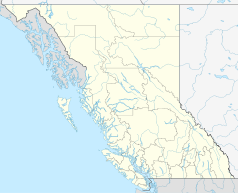Ladysmith (British Columbia)
| Ladysmith | ||
|---|---|---|
| Location in British Columbia | ||
|
|
||
| State : |
|
|
| Province : | British Columbia | |
| Regional District : | Cowichan Valley | |
| Coordinates : | 49 ° 0 ′ N , 123 ° 49 ′ W | |
| Height : | 40 m | |
| Area : | 11.99 km² | |
| Residents : | 7921 (as of 2011) | |
| Population density : | 660.6 inhabitants / km² | |
| Time zone : | Pacific Time ( UTC − 8 ) | |
| Postal code : | V9G | |
Ladysmith is one of the older European settlements on Vancouver Island , a large island off the west coast of Canada. Their appearance corresponds to that of a small town in the early 20th century. The place is located 23 km south of Nanaimo and 88 km north of Victoria on the east coast in the Cowichan Valley Regional District .
The small town is internationally known mainly as the birthplace of Pamela Anderson .
history
Originally the area was settled by the First Nation of Chemainus . Since approx. 3000 BC They live in Kulleet Bay (in the Yellowpoint area), Shell Beach (across from Ladysmith Harbor) and Coffin Point near Elliot Beach Park . From 1884 their land was increasingly sold. The Chemainus First Nation and their villages Shts'um'inus, Thuq'mi'n and Hwkwumluwhuthun were relocated to what is now Chemainus Indian Reserve 13 , one of four reservations the tribe now inhabits.
In 1899 James Dunsmuir founded the place under the name Oyster Harbor to settle the workers of the coal mines in Extension 19 km to the north. He also had the railway line from Victoria expanded. In 1900 the name was changed to the South African town of Ladysmith , which had been besieged during the Boer War , and in 1904 it was incorporated into local government . Numerous streets in the village were named after British army leaders.
As early as 1911, the city had 3,300 inhabitants, including numerous Chinese , Finns , Belgians and Croatians . The biggest employers were the coal mines. But the mines were poorly secured, and methane gas explosions cost the lives of numerous miners. On October 5, 1909, one such explosion killed 32 men in the Extension Pit. It was these uncertain conditions that led to a long strike in many mines in western Canada in 1912-14. At the same time, the need for coal began to decline. So the mine was closed in April 1931. Ladysmith lost almost half of its population.
In 1935, the Comox Logging and Railway Company acquired part of the Douglas fir forest from the Rockefellers . At the end of the 1940s, the timber industry employed around 700 people. It was only at the end of the 1980s that the industrial monoculture, which had repeatedly exposed the city to booms and catastrophes, be it coal or the timber industry, was broken up. Oyster fishing and tourism play an increasing role.
Downtown revitalization also began in the 1980s with the display of historical artifacts on 1st Avenue and Transfer Beach. The houses have been restored, information boards have been put up, and photos of the city from 1890 to 1970 are on permanent display. A shop with furnishings from the 1950s can be found on the main street, plus numerous artists who have settled here. In addition, the city is now pursuing a policy of reconciliation with the Chemainus First Nation and the Hul'qumi'num Treaty Group , which is seeking a treaty with the government.
Demographics
The 2011 census revealed a population of 7,921 inhabitants for the municipality. The population only increased by 5.1% compared to the 2006 census, while the population in the entire province of British Columbia grew by 7.0% at the same time.
traffic
An airport ( Nanaimo Airport , 9 km north), a railway line (used by Esquimalt and Nanaimo Railway ) and the busy Trans-Canada Highway ( Highway 1 ) connect the small town with the main centers of Vancouver Island and the province.
See also
literature
- John R. Hinde: When Coal was King: Ladysmith and the Coal-Mining Industry on Vancouver Island. University of British Columbia Press, Vancouver 2003
- Brian D. Thom: Coast Salish Senses of Place. Montreal: Dissertation, McGill University 2005.
- Ladysmith: 100 Years, 1904-2004. Ladysmith: Take 5 Centennial Committee 2005
sons and daughters of the town
- Pamela Anderson (* 1967), actress
Web links
- Ladysmith . In: BC Geographical Names (English)
- Ladysmith ( English, French ) In: The Canadian Encyclopedia .
- Official site of the city
supporting documents
- ↑ Statistics Canada (2011 Census). Ladysmith Community Profile , accessed July 5, 2012

